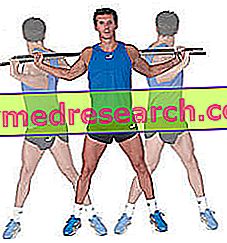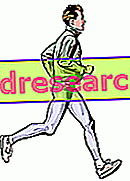By Dr. Dario Mirra
Introduction
In view of the summer, like every year, the run on the flat stomach begins, so we begin to give in with thousands of repetitions to train the abdominal muscles, to chisel the belly and the waist, to then move on to the torsions of the bust, with the purpose of thinning the hips.

And what if this workflow as well as being useless was also harmful?
Abdominal muscles and their functions
Below is a rundown of the central muscles of our body.
Lateral belly muscles:
- Square of the loins, with its 3 beams: 1) iliac-costal, 2) cost-vertebral, 3) iliac-vertebral.
- Psoas.
Their action causes the trunk to tilt from the side of their contraction, with the difference that the square of the loins has no action on the lumbar lordosis, while the psoas determines a hyperlordosis and a simultaneous rotation of the trunk on the side opposite to its tensioning.
Anterior belly muscles:
- Abdominal rectum.
- Transverse.
- Small oblique.
- Great oblique.
The two oblique muscles intertwine like a lozenge, so if we look at the purely aesthetic aspect it is necessary to have a good tonicity of these muscles and a low amount of fat.
In the rotational movements they act as protagonists of the work:
- vertebral shower muscles.
- Large muscles of the abdomen.
In the flexion movements all the abdominal muscles intervene, because being located in front of the spinal axis are all flexors of the trunk.
Posterior muscles of the lower back, located on 3 floors:
1- deep floor:
- spinal transverse.
- interspinous muscles.
- epispinoso muscle.
- long dorsal muscle.
- lumbar sacral muscle or costal ileum.
All these muscles form the common mass.
2- medium floor:
- small serrated back.
- small upper toothed.
3- surface plane:
- gran dorsal muscle.
These muscles, as a whole, have the following functions:
- extend the lumbar spine.
- Accentuate lumbar lordosis.
- They pull the lumbar vertebrae behind and bend them.
- They do not have the function of straightening on the lumbar spine.
- They have a strong role in forced expiration.
In all the anatomy books we describe the classic functions of different muscles, such as flexors, rotators, extenders, etc. even if this concept is a bit prehistoric, and still valid in theory, it is a little less so in a practical perspective.
Core stability
This concept has now become overbearing in gyms, even if the idea behind it may not yet be completely clear.
Consistent with the idea of core stability, the central muscles are looked after, no longer in a perspective of isolation, as happens for example during the classic crunch, but placing them in a global context of body stabilization; the idea also foresees to counteract the movement through contractions at different degrees and tensions of these structures, seen from the point of view of no longer performing a movement, but in limiting it, for example no longer in having the trunk bent, but by contrasting a extension of the latter.
Torsion of the torso and spine
When training, a common mistake is to think only of the aesthetic advantage that can be drawn from a given job, often neglecting its repercussions on the structure; a case in point is precisely the traumatic impact of continuous torsions of the bust on the integrity of our spine.
We have all performed this exercise, without exception.
I still see in the gym people who perform this exercise with an enthusiasm and an enviable articular excursion, almost a 360 ° twist, as an exorcist, so to speak.
Basics of anatomy and biomechanics of the lumbar spine
All have more or less on their heads a classic schemino of the vertebral column, formed by the superposition of bony structures called vertebrae, separated by a fibrocartilaginous disk. From this description it might seem that the two vertebrae separated from the disk may be 3 structures in their own right, but this is not the case at all.
The structural integrity of the column is ensured by many elements such as:
- Anterior longitudinal ligament.
- Posterior longitudinal ligament.
- Yellow ligament.
- Interspinous ligament.
- Thorny ligament.
- Inter-transversal ligament.
- Intervertebral disc.
- Interapophyseal joint capsule.
All these structures, in a common way, help to support the "articular paradox", which is to guarantee stability and mobility simultaneously.
If we take the intervertebral disc as a ligamentous element, and represent it as not extensible, it is easy to imagine that a torsion movement always accompanies with an approach of the upper plate of a vertebra to the lower plate of the overlying vertebra: this leads to a crushing of the disc and a decrease in the diameter of the conjugate foramen.
So it must be imagined that with every torsion of the bust done in the gym there is always a choking of the disc and the structures that pass inside the conjugation channel.
Furthermore, the facet joints of the lumbar vertebrae are oriented on a parasagittal plane, therefore anatomically they are not suitable for twisting.
And again if the 2 contiguous vertebrae are always taken into account in a rotation movement, the resulting rotation will be given by a rotation combined with a contemporary sliding.
According to GG Gregersen and DB Lucas, the total mobility of the lumbar spine is 10 °!
If we have 5 lumbar vertebrae, we are only 2 ° total degrees per vertebra, therefore a degree of rotation to the right and one to the left.
So if our intent is to work the abdominal musculature mostly located in the lumbar area, what good is it to do this exercise with contortionist rotations if we have a total mobility of only 2 degrees for each vertebral level?
Working hypothesis
On the basis of the above, the work on the abdominals could make use, in addition to the classic exercises, of:
- classic training with dumbbells and barbells with high load, so as to require strong stabilization of the central musculature.
- Exercises of crunches and inverse crunches with overload.
- Work with instability, so as to require continuous tension and adjustments on the part of this musculature.
- Work in plank type isometry at different angles, positions and degrees.
Conclusions
Those listed above can be valid means to set up a good job on the core muscles, finally trying to get rid of the prehistoric idea of working the right abdominals with thousands of repetitions, with the torsions of the bust or with the various fashions and continue ... doing only what you need in an aesthetic and functional perspective, and at the same time trying to create as few damage as possible to the structures.



